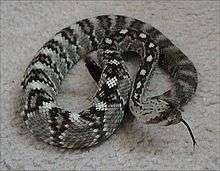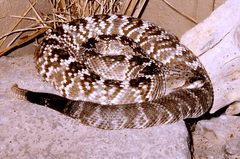Crotalus molossus
| Crotalus molossus | |
|---|---|
 | |
| Scientific classification | |
| Kingdom: | Animalia |
| Phylum: | Chordata |
| Subphylum: | Vertebrata |
| Class: | Reptilia |
| Order: | Squamata |
| Suborder: | Serpentes |
| Family: | Viperidae |
| Subfamily: | Crotalinae |
| Genus: | Crotalus |
| Species: | C. molossus |
| Binomial name | |
| Crotalus molossus Baird & Girard, 1853 | |
.png) | |
| Synonyms | |
Crotalus molossus is a venomous pit viper species found in the southwestern United States and Mexico. Four subspecies are currently recognized, including the nominate subspecies described here.[4]
Description

This medium-sized species[2] averages from 76 to 107 cm (30 to 42 in) in length.[5] Large specimens are usually not much more than 100 cm (39 in) long, although lengths of 125.0 cm (49.2 in) (Gloyd, 1940), 125.7 cm (49.5 in) (Klauber, 1972), and 129.5 cm (51.0 in) (Shaw & Campbell, 1974) have been reported.[2] The females tend to be larger than the males.
They range in color from yellows and olive greens to browns and black. As their name implies, one of their most distinguishing features is, despite variations in body color, the tail scales are entirely black. Often, this rattlesnake has a black band across its eyes and diagonally down to the corners of its mouth, forming a sort of facial 'mask'.
Like other rattlesnakes, C. molossus has a rattle composed of keratin on the end of its tail. Each time the snake sheds its skin, a new segment is added to the rattle. They can shed their skin several times a year, and the rattle is fairly fragile and can be broken, so the length of a rattlesnake's rattle is not an accurate measure of its age, unless the terminal button is intact.
Geographic range
It is found in the southwestern United States in Arizona, New Mexico and west and central Texas, and Mexico as far south as Oaxaca. Also it is found in the Gulf of California on San Estéban and Tiburón Islands. The distribution reaches a maximum elevation of 2930 m. Although it has been recorded being seen at as high of an altitude as 6900 feet at the McDonald Observatory in the Davis Mountains of West Texas. The type locality given is "Fort Webster, St. Rita del Cobre, N. Mex." (Fort Webster, Santa Rita del Cobre, Grant County, New Mexico, USA).[1]
Conservation status
This species is classified as Least Concern IUCN Red List of Threatened Species (v3.1, 2001).[6] Species are listed as such due to their wide distribution, presumed large population, or because they are unlikely to be declining fast enough to qualify for listing in a more threatened category. The population trend was stable when assessed in 2007.[7]
Behavior

All rattlesnakes are carnivorous, their primary food sources being rodents, other small mammals, birds, and small reptiles. The behavior of northern black-tailed rattlesnakes varies over the course of a year. In the spring and fall, they are primarily diurnal. In the summer, they shift to a nocturnal behavior, to avoid the heat of summer. In the winter, they hibernate in dens created and abandoned by other animals, often with other species of snakes. They are variable in their form of locomotion depending on what substrate they need to traverse and will actively change between sidewinding or rectilinear movement. Although it is an able climber and expert swimmer, C. molossus is primarily a terrestrial species and inhabits grasslands, desert areas, and rocky and mountainous areas, as well as high-altitude forested habitats.
Docility and Defense
C. molossus is often considered the most docile rattlesnake ever, because of their placid and curious attitude. Bites rarely occur because of this. They rely mostly on camouflage to avoid trouble. C. molossus normally tries to back away when confronted, but will rattle when cornered and threatened.
Venom
The venom of the C. molossus has a hemotoxic venom, like most Crotalids. The venom is not considered fatal to humans, but victims still need to seek medical attention if bitten. Fatalities are extremely rare. CroFab antivenom is often used to treat bites.
Reproduction
Breeding occurs in the spring when males follow the pheromone trails of the females. Copulation can sometimes last for hours and happen multiple times over a period of days. After mating, the male often stays near the female for several days to prevent any other males from mating with her. The female gives birth to live young in the summer, and the babies stay with the mother only until they wander off on their own, usually less than a day or two. Females are believed to breed every year, and can have litters as large as 10-12 young, but usually average four to six. Their lifespans average 15–20 years.
Taxonomy
A recent revision [8] showed that eastern populations, from Texas and central and eastern New Mexico, form a distinct species separate from C. molossus: Crotalus ornatus Hallowell 1854.
Subspecies
| Subspecies[4] | Taxon author[4] | Common name | Geographic range |
|---|---|---|---|
| C. m. estebanensis | Klauber, 1949 | San Esteban Island black-tailed rattlesnake | Mexico: Isla San Esteban (Gulf of California) |
| C. m. molossus | Baird & Girard, 1853 | Northern black-tailed rattlesnake | United States (Arizona, New Mexico, southwest Texas), Mexico |
| C. m. nigrescens | Gloyd, 1936 | Mexican black-tailed rattlesnake | Mexico (South Sonora, southwest Chihuahua, southern Coahuila, south to Oaxaca and Veracruz, Tlaxcala) |
| C. m. oaxacus | Gloyd, 1948 | Oaxacan black-tailed rattlesnake | Mexico (Oaxaca) |
See also
- List of crotaline species and subspecies
- Crotalus by common name
- Crotalus by taxonomic synonyms
- Crotalinae by common name
- Crotalinae by taxonomic synonyms
- Snakebite
References
- 1 2 McDiarmid RW, Campbell JA, Touré T. 1999. Snake Species of the World: A Taxonomic and Geographic Reference, vol. 1. Herpetologists' League. 511 pp. ISBN 1-893777-00-6 (series). ISBN 1-893777-01-4 (volume).
- 1 2 3 Campbell JA, Lamar WW. 2004. The Venomous Reptiles of the Western Hemisphere. Comstock Publishing Associates, Ithaca and London. 870 pp. 1500 plates. ISBN 0-8014-4141-2.
- ↑ Wright AH, Wright AA. 1957. Handbook of Snakes of the United States and Canada. Comstock Publishing Associates. Ithaca and London. (7th printing, 1985). 1105 pp. ISBN 0-8014-0463-0.
- 1 2 3 "Crotalus molossus". Integrated Taxonomic Information System. Retrieved 24 February 2007.
- ↑ Conant R. 1975. A Field Guide to Reptiles and Amphibians of Eastern and Central North America. Second Edition. [First published in 1958]. Houghton Mifflin Company. Boston. 429 pp. 48 plates. ISBN 0-395-19979-4 (hc), ISBN 0-395-19977-8 (pb).
- ↑ Crotalus molossus at the IUCN Red List. Accessed 13 September 2007.
- ↑ 2001 Categories & Criteria (version 3.1) at the IUCN Red List. Accessed 13 September 2007.
- ↑ Anderson, C. G., and E. Greenbaum. 2012. Phylogeography of northern populations of the black-tailed rattlesnake (Crotalus molossus Baird and Girard, 1853), with the revalidation of C. ornatus Hallowell, 1854. Herpetol. Monogr. 26: 19–57.
External links
| Wikimedia Commons has media related to Crotalus molossus. |
- Crotalus molossus at the Reptarium.cz Reptile Database. Accessed 12 December 2007.
- Crotalus molossus at Herps of Texas. Accessed 24 February 2007.
- Black-tailed Rattlesnake at Centennial Museum & Chihuahuan Desert Gardens Natural and Cultural History. Accessed 24 February 2007.
- Crotalus molossus, Black-tailed Rattlesnake at California Reptiles and Amphibians. Accessed 24 February 2007.
- Crotalus molossus molossus at Munich AntiVenom INdex. Accessed 24 February 2007.
